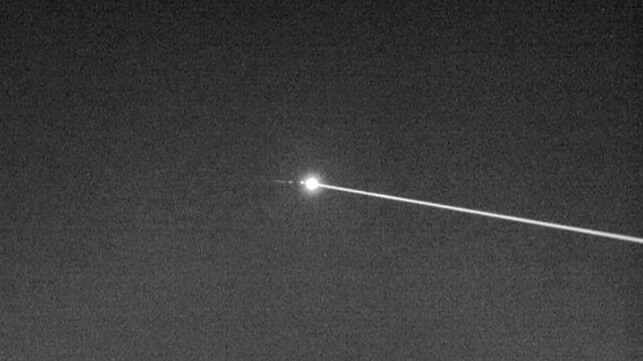In a First, U.S. Navy Shoots Down Cruise Missile With a Laser System

The U.S. Navy reports that it has shot down a simulated cruise missile using an all-electric laser weapon for the first time ever.
The Navy has used a laser to shoot down a missile before - but long ago, and with a much different technology. During the MIRACL chemical-laser research program in the 1980s-90s, the Navy's deuterium fluoride laser system shot down high-speed aerial targets in multiple test runs. Though extremely powerful, MIRACL was ultimately abandoned due to the challenges of handling its toxic fuel in the field.
A solid-state, all-electric laser is an entirely different weapons system, and the Navy has been working on increasingly-powerful solid state lasers for many years. The system tested in February was the Layered Laser Defense (LLD), designed and built by Lockheed Martin. It is another demonstrator for technology to counter drones and fast-attack boats, like the earlier LaWS system. It can also use its high-resolution telescope to track airborne threats and conduct battle damage assessment after engaging a target.
The drone shoot-down was part of a recent Navy test at the U.S. Army’s White Sands Missile Range in New Mexico. During the recent test at White Sands, the LLD tracked or shot down multiple targets, including unmanned fixed-wing drones, quadcopters and high-speed drones that simulate subsonic cruise missiles.
The Navy is developing laser weapons because of their precision, speed and "bottomless" magazine, without the hazard of keeping propellants and explosives on board. Modern high-power lasers run on the ship's electrical service, making them inherently safer than traditional guns and cannons. They can keep running for as long as a ship has power, and the main "cost per round" is the cost of the fuel to run the generators.
“Innovative laser systems like the LLD have the potential to redefine the future of naval combat operations,” said Chief of Naval Research Rear Adm. Lorin C. Selby. “They present transformational capabilities to the fleet, address diverse threats, and provide precision engagements."
The Office of Naval Research (ONR) has been working on this capability for many years. In 2014, ONR tested the Laser Weapon System (LaWS) aboard the USS Ponce in the Persian Gulf. More recently, ONR fielded the Laser Weapon System Demonstrator (LWSD) aboard the USS Portland in 2021.
The Navy says that there is no plan to field the LLD, but it provides some insight into the future of laser weapons. It is compact, powerful, and more efficient than previous systems, and the Navy says that it incorporates artificial intelligence to improve tracking and targeting.
“LLD is an example of what a very advanced laser system can do to defeat significant threats to naval forces,” said David Kiel, a former Navy captain who is a program officer in ONR’s Aviation, Force Projection and Integrated Defense Department, which managed the testing. “And we have ongoing efforts, both at ONR and in other Navy programs, to keep building on these results in the near future.”
